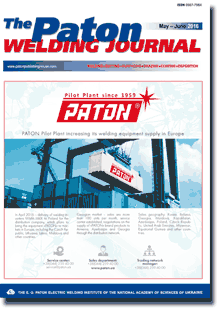| 2016 №06 (22) |
DOI of Article 10.15407/tpwj2016.06.23 |
2016 №06 (24) |

The Paton Welding Journal, 2016, #5-6, 134-136 pages
Application of additive technologies for growing large profiled single crystals of tungsten and molybdenum
V.A. Shapovalov, V.V. Yakusha, A.N. Gnizdylo And Yu.A. Nikitenko
E.O. Paton Electric Welding Institute, NASU 11 Kazimir Malevich Str., 03680, Kiev, Ukraine. E-mail: office@paton.kiev.ua
Abstract
The paper considers application of additive welding technologies with regard to growing the super large single crystals of refractory metals. Main methods of tungsten and molybdenum single crystals production from liquid phase were analyzed. The perspectives of plasma-induction technology for growing the large plane single crystals of tungsten and molybdenum are shown. A process scheme of additive growth of the plane single crystals of refractory metals using plasma-induction method is described. It is determined that the developed method provides for the possibility of flexible regulation of thermal field of single crystal being grown. Application of local molten zone, formed by low power plasma arc with the parameters typical for welding processes, allows growing the tungsten large single crystals of 210?x180x20 mm size. The crystals are formed under conditions of heating with inductor high-frequency field to the temperature typical for hot deformation range. Given are the results of investigation of structural perfection of the growing crystals which verify the fact that the conditions of single crystals formation in plasma-induction zone melting provide for higher quality of single-crystalline structure than the methods, in which additional heating (electron beam and plasma-arc) is not used. It is determined that the plasma-induction process is characterized by formation of the regular dislocation structures, for which dislocation coalescence in low-angel boundaries are typical. 9 Ref., 7 Figures.
Keywords: additive welding technologies, plasma-arc zone melting, tungsten and molybdenum single crystals, dislocation substructure
Received: 21.04.16
Published: 19.07.16
References
- Manokhin, A.I., Burkhanov, G.S. (1987) State-of-the-art of problem of metal single crystals. In: High-frequency and single crystal metallic materials, 5–13. Moscow: Nauka.
- Kervalishvili, I.D., Shchelkin, Yu.F. (1982) Heat conditions — factor determining the manufacturing of perfect crystals. Fizika i Khimiya Obrab. Materialov, 5, 70–78.
- Predtechensky, B.S., Starostina, L.S. (1972) Dislocations in molybdenum single crystals produced by zone melting. In: Growth and defecfs of metal crystals, 213–217. Kiev: Naukova Dumka.
- Glebovsky, V.G., Semenov, V.N., Lomejko, V.V. (1987) Influence of crystallization conditions on structural perfection of tungsten single crystals. In: High-pure and single-crystal metallic materials, 38–42. Moscow: Nauka.
- Savitsky, E.M., Burkhanov, G.S., Raskatov, N.N. (1978) Application of plasma heating for growing the single crystals of refractory metals. In: Metal single crystals, 5–10. Moscow: Nauka.
- Shapovalov, V., Yakusha, V., Manulyk, A. (2015) Large refractory metals single crystals grown by plasma-induction zone melting. In: of 24th Int. Materials Research Congress (Cancun, Mexico, 16–20 Aug., 2015).
- Shapovalov, V.A., Yakusha, V.V., Nikitenko, Yu.A. (2014) Investigation of temperature field of profiled tungsten single crystals made by plasma-induction method. Elektrometallurgiya, 3, 31–35.
- Smirnov, V.P. (2008) Thermonuclear power as the major international innovative project. Khimich. Zhurnal, 6, 79–94.
- Filatov, O.G., Mazul, I.V. (2003) NII EFA experimental complex for simulation of operational factor of first wall of ITER reactor. Voprosy Atomn. Nauki i Tekhniki, 3, 3–31.
